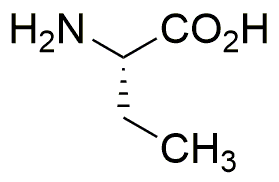L-a-Aminobutyric acid is widely utilized in research focused on:
- Neuroscience: This compound acts as a neurotransmitter and is studied for its role in modulating synaptic transmission, making it valuable for understanding conditions like anxiety and depression.
- Agriculture: It serves as a plant growth regulator, promoting root development and improving stress tolerance in crops, which can lead to higher yields and better quality produce.
- Pharmaceuticals: Used in the synthesis of various drugs, it has potential applications in developing treatments for neurological disorders due to its neuroprotective properties.
- Food Industry: As a flavor enhancer, it can improve the taste profile of certain food products, appealing to manufacturers looking to enhance consumer satisfaction.
- Biotechnology: In cell culture, it is utilized to support the growth of specific cell lines, aiding researchers in developing new therapies and conducting experiments more effectively.
General Information
Properties
Safety and Regulations
Applications
L-a-Aminobutyric acid is widely utilized in research focused on:
- Neuroscience: This compound acts as a neurotransmitter and is studied for its role in modulating synaptic transmission, making it valuable for understanding conditions like anxiety and depression.
- Agriculture: It serves as a plant growth regulator, promoting root development and improving stress tolerance in crops, which can lead to higher yields and better quality produce.
- Pharmaceuticals: Used in the synthesis of various drugs, it has potential applications in developing treatments for neurological disorders due to its neuroprotective properties.
- Food Industry: As a flavor enhancer, it can improve the taste profile of certain food products, appealing to manufacturers looking to enhance consumer satisfaction.
- Biotechnology: In cell culture, it is utilized to support the growth of specific cell lines, aiding researchers in developing new therapies and conducting experiments more effectively.
Documents
Safety Data Sheets (SDS)
The SDS provides comprehensive safety information on handling, storage, and disposal of the product.
Product Specification (PS)
The PS provides a comprehensive breakdown of the product’s properties, including chemical composition, physical state, purity, and storage requirements. It also details acceptable quality ranges and the product's intended applications.
Certificates of Analysis (COA)
Search for Certificates of Analysis (COA) by entering the products Lot Number. Lot and Batch Numbers can be found on a product’s label following the words ‘Lot’ or ‘Batch’.
Numéro de catalogue
Numéro de lot/série
Certificates Of Origin (COO)
This COO confirms the country where the product was manufactured, and also details the materials and components used in it and whether it is derived from natural, synthetic, or other specific sources. This certificate may be required for customs, trade, and regulatory compliance.
Numéro de catalogue
Numéro de lot/série
Safety Data Sheets (SDS)
The SDS provides comprehensive safety information on handling, storage, and disposal of the product.
DownloadProduct Specification (PS)
The PS provides a comprehensive breakdown of the product’s properties, including chemical composition, physical state, purity, and storage requirements. It also details acceptable quality ranges and the product's intended applications.
DownloadCertificates of Analysis (COA)
Search for Certificates of Analysis (COA) by entering the products Lot Number. Lot and Batch Numbers can be found on a product’s label following the words ‘Lot’ or ‘Batch’.
Numéro de catalogue
Numéro de lot/série
Certificates Of Origin (COO)
This COO confirms the country where the product was manufactured, and also details the materials and components used in it and whether it is derived from natural, synthetic, or other specific sources. This certificate may be required for customs, trade, and regulatory compliance.


